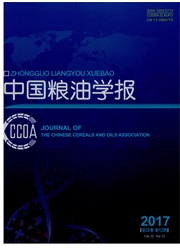

 中文摘要:
中文摘要:
为完善辐照技术防治储粮虫霉的理论,研究了电子束辐照对绿豆象种群发育及对绿豆品质的影响。绿豆象的卵、幼虫、蛹和成虫经0.1—1.0kGy剂量的电子束辐照后,卵和幼虫在辐照的虫态死亡;蛹发育至成虫和成虫的死亡率显著增加,其种群存活个体的产卵总量显著减少;辐照处理种群的F1代不能孵化为幼虫或在l-2龄幼虫时全部死亡,而0.2kGy及以上的辐照剂量则能完全抑制F1代孵化为幼虫。尽管0.2kGy的辐照剂量使绿豆的苗高下降了17%,脂肪酸值升高了12%,但对其发芽率、发芽势、可溶性蛋白质含量、降落数值和过氧化氢酶活性无显著影响,并且提高了绿豆的糊化液黏度。因此,推荐0.2kGy的电子束辐照作为有效防治绿豆中绿豆象的参考剂量。
 英文摘要:
英文摘要:
To improve the theory about application of irradiation technique for pest disinfection and sterilization in grain storage, effects of electron beam radiation on the population development of Callosobruchus chinensis L. and the quality of mung beans were investigated in this study. When eggs, larvae, pupae and adults of C. chinensis were irradiated with 0.1 - 1.0 kGy electron beam, no irradiated eggs, and larvae could survive and develop into the next stage, the mortality rate of irradiated pupae and adults was significantly elevated and F1 of irradiated populations could not hatch into larvae or died at the stage of first - or second - instar larvae. Furthermore, the exposure of C.ing exposed to 0.2 kGy electron beams. It was concluded that 0.2 kGy could be used as a reference dose of electron beam irradiation to control C. chinensis during the storage of mung beans.
 同期刊论文项目
同期刊论文项目
 同项目期刊论文
同项目期刊论文
 期刊信息
期刊信息
